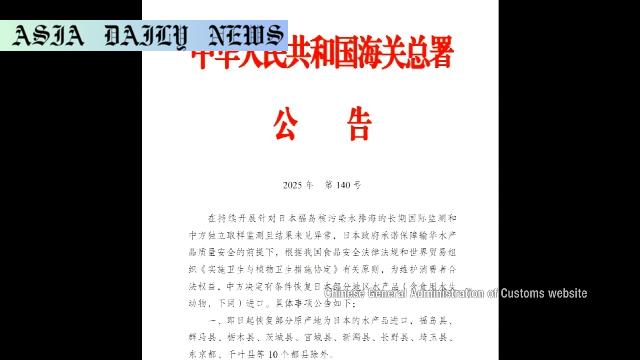Japanese seafood imports resume: China reopens market with strict monitoring except for 10 restricted prefectures.
China reopens seafood import procedures for Japan, finishing a two-year suspension.
Japanese seafood from 10 specific prefectures, like Fukushima, remains banned.
Registered Japanese facilities must meet strict Chinese standards on food safety and radioactivity.
China emphasizes rigorous checks and vows to protect citizens’ health and safety.

Introduction: China Revives Japanese Seafood Imports
China has officially reinstated procedures to allow Japanese seafood imports after a two-year suspension, bringing significant economic and diplomatic implications. This decision follows Japan’s controversial release of treated and diluted water from the Fukushima Daiichi nuclear power plant into the ocean. The move, announced by China’s General Administration of Customs, allows the importation of products from Japan under stringent safety measures, but excludes items from 10 prefectures, such as Fukushima, Miyagi, and Tokyo. This step reflects Beijing’s cautious but measured approach to reopening its market while emphasizing public health security.
Stringent Regulations for Import Resumption
Despite the reopening, the Chinese government has emphasized strict regulations to ensure food safety and consumer protection. Japanese seafood businesses seeking to export to China must register their processing facilities with Chinese authorities and provide certifications of sanitation, radioactive materials, and place of production from Japanese officials. This multilayered monitoring system aims to uphold China’s stringent food safety standards. Furthermore, Beijing has clarified that it reserves the right to take necessary measures to protect public health if any violations of standards are detected or if Japan falls short in its supervisory responsibilities.
Exclusions and Historical Context
Seafood imports from 10 Japanese prefectures will continue to remain banned, a precaution rooted in China’s concerns about potential radioactive contamination from the Fukushima disaster. This decision follows the temporary full suspension of Japanese seafood imports in August 2023 after Japan began releasing treated water into the Pacific Ocean. While Japan has maintained that the release complies with international safety standards, China and several other countries initially expressed strong opposition. The current development demonstrates a delicate balancing act, as Beijing cautiously resumes imports while keeping stringent safeguards in place.
Geopolitical Implications and Economic Impact
The reopening of China’s market for Japanese seafood is a significant step in fostering economic ties between the two nations amidst a complex geopolitical landscape. Seafood trade represents an essential segment of Japan’s economy, and the prolonged suspension has inflicted notable financial losses on Japanese fisheries. On the other hand, it signals China’s willingness to engage in pragmatic economic diplomacy despite longstanding tensions with Japan over a myriad of historical and regional issues. By reopening the market under strict conditions, Beijing is also sending a message about its commitment to consumer safety and regulatory integrity.
Looking Ahead: Benefits and Challenges
As both countries move forward with renewed trade, challenges regarding trust and compliance with safety standards persist. For Japanese exporters, the process of ensuring compliance with rigorous Chinese requirements may involve additional costs and logistical complexities. At the same time, China faces the task of maintaining a robust monitoring system to address public concerns and ensure the safety of imported products. However, this development could pave the way for improved bilateral ties, benefiting not just the seafood industry but also broader economic partnerships. What remains to be seen is how effectively the two nations navigate these challenges in the coming months.



Commentary
China’s Strategic Approach to Japanese Seafood Imports
The resumption of Japanese seafood imports by China is a decision that highlights the interplay between economic considerations and public health concerns. Given the sensitive nature of the issue, it is evident that this move is not just a routine policy change but a calculated step designed to maintain balance between fostering economic cooperation and addressing domestic safety concerns. By allowing imports except from the 10 restricted prefectures, China is sending a message that it values trade relations but will not compromise on its safety protocols.
Implications for Japan: A Ray of Hope
For Japan, this development comes as a relief for its fisheries industry, which has faced mounting challenges since the suspension two years ago. The reliance on a robust export market, particularly in countries like China, underscores the importance of resuming trade ties. Yet, Japan must demonstrate transparency and diligence in meeting Chinese requirements, as failure to do so could lead to renewed suspensions, further complicating business operations. This is a pivotal moment for Japanese exporters to reinforce their commitment to safety and quality.
Navigating Complex Geopolitical Relations
This decision also reflects the broader geopolitical dynamics between China and Japan. Although both nations maintain divergent stances on several historical and territorial issues, the resumption of trade signifies a willingness to engage economically despite these differences. Such developments remind us of the intricate web of diplomacy, commerce, and politics that governs international trade relationships. Ultimately, the success of this initiative will depend on the mutual commitment both nations exhibit toward ensuring safety, trust, and cooperation.